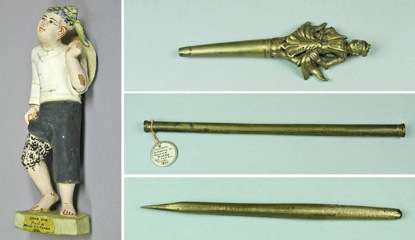Burmese Tattooing
Shan people, Burma, 19th century
 Collected and donated by Richard Carnac Temple before 1894; 1894.27.29 and 1890.13.18, .24–.25The Shan people live in an area incorporating parts of Burma (Myanmar), Thailand, China and Laos and it has been suggested that their tattoos incorporate both Buddhist and animist elements of the their cosmological world-view.
Collected and donated by Richard Carnac Temple before 1894; 1894.27.29 and 1890.13.18, .24–.25The Shan people live in an area incorporating parts of Burma (Myanmar), Thailand, China and Laos and it has been suggested that their tattoos incorporate both Buddhist and animist elements of the their cosmological world-view.
Shan tattooing based on Burmese script is one of the two main historical tattooing traditions in mainland Southeast Asia, the other originating in Cambodia. This wooden figurine is hitching up his trousers to show us the most widely known type of tattoo – "pants" that begin at the waist and extend down to the knee. Such tattoos were primarily decorative and were received by men during a rite of passage at puberty. Women would not normally consider a man for marriage unless he had the pants tattoo and it can still be seen among older members of the Shan community. Tattooing such a large expanse of skin covering both the front and back of the thighs and groin was a long and process and initiates were often given opium to smoke to lessen the pain.
Whilst the pants tattoo was always done in blue-black – the ink traditionally made from soot mixed with liquid – other types of tattoo were done in red. Types of tattoo still commonly worn by both Shan men and women are those with a 'medical' purpose, which act variously like vaccinations or armour. For this reason the tattooist is usually a monk or a doctor and they use tools appropriate for the purpose, traditionally crafted out of brass and often topped with a Buddhist deity as shown here. Some of the power represented by this divine figure was transferred to the person being tattooed. Tools like this went out of fashion in the 1920s as people came to prefer faster and less painful electric tattoo machines.
The protective ability of these tattoos works in one or several ways: by rendering potential enemies fearful or full of admiration, by increasing a person's defensive powers, or by creating a tangible barrier that repels animal bites, knives or bullets. The latter tend to be quite large and a common anti-bullet tattoo is a large pig on a person's back. The effectiveness of such tattoos is not really related to their form, which varies, but is instead dependent on the wearer observing certain dietary restrictions and keeping at least one of the Five Precepts of the Buddhist code of ethics (to refrain from killing, stealing, improper sexual behaviour, telling falsehoods and drunkenness).
